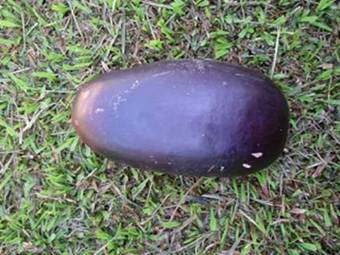SICANIA
ODORIFERA
POPULAR
NAMES: Cruá,
Jamelão, Melão caboclo and Cassabanana.
CUCURBITACEAE

Purple
Cruá
variety
INDIGENOUS NAME:
Cruá
is the
A-cara-ibá
from guarani language meaning "fruit like the potato face".
Characteristics:
The plant is a perennial
semi-climber, very vigorous and heavy, with branches to climb and reach up
to
15
m
(50 feet) in
length.
The young stems are
hairy and have the burdocks with adhesive disks that adhere firmly to any
smooth surface.
The stems are fibrous
and the base measures
12 cm
in diameter.
The leaves arise on long
petioles or stems of
4
to
12 cm;
they
are deeply in the basic
chords (like the heart), orbicular (has a circular shape), with
wavy or toothed
margins, up to
30 cm
in
width and
length, with rough texture on the underside.
The yellow flowers are
solitary and campanulate (have the shape of bell) and measuring
5 cm
in diameter.
There
are two varieties, the red and purple, you see the purple.
Planted in
the site of Frutas Raras:
For the first time
planted in September 1999, bloomed for the first time in 2000.
Tips for
cultivation:
Plant resistant to low temperatures (down to -5°C (23°F)), prefers high
places (altitude higher than
600 m (2,000
feet)).
The
soil should be deep, moist, neutral, with sandy or clay formation (red soil).
You must plant at least 2 plants to have a cross-pollination.
Propagation: The
seedlings are formed from seed to be planted directly into holes in the
final turn, at the beginning of September. Sow
4
to
5 seeds per hole,
after which germination occurs in 30 days, it is expected another 40 days to
select the most beautiful plant, eliminate the other.
Planting:
We need to do in
grapevine trellis (in the horizontal with the minimum of
2 m (6 2/3 feet)
wide by
6 m (20 feet) in
length. Space 4 x 4 m (13 x 13 feet).
Add to the hole
1 kg of
limestone,
1 kg
of ash
and
5 to
8 kg of
organic matter well
mixed.
Water weekly for the first 3 months, then only water is absent at the
time of bloom.
Cultivating: In
places with more mild weather in winter, the plant survives for 2 or 3 years,
in which case you should do all the pruning of branches with a diameter less
than
2 cm
in diameter.
Fertilize with organic compost, can be (5
kg)
)
poultry litter + 50 g of NPK 4-14-8 distributed in the soil into two
sections, one in early October and the remainder in December.
Uses:
The fruits are
consumed in natura, in the form of jams, jellies, juices and ice creams.
Flowering
in site of Frutas Raras:
November and February.
Fruting in
the site of Frutas Raras:
May to
August.
LEARN MORE ABOUT THE CLASSIFICATION,
ORIGIN, HISTORY, STATEMENT OF PLAN, CULTURAL PRACTICES, MEDICINAL PROPERTIES
IN THE PORTUGUESE LANGUAGE
BUY THE BOOK
“COLECIONANDO FRUTAS”
Back to the
seedlist (English)
or
back to Cucurbitaceae
(Portuguese)
